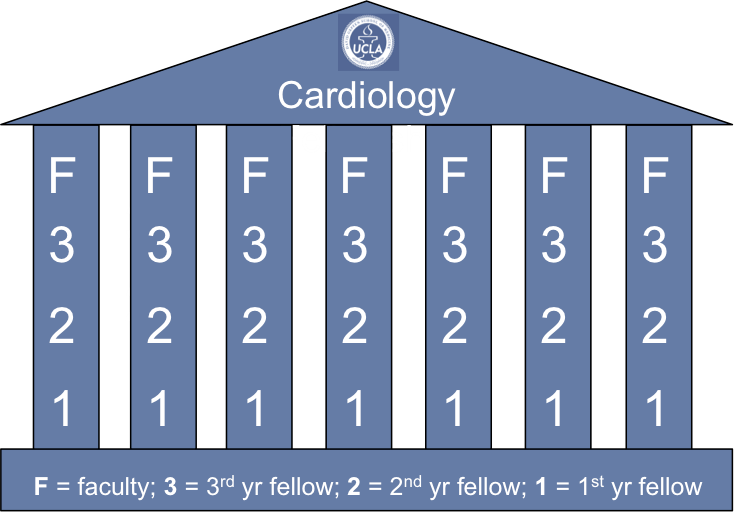During my first year of general cardiology fellowship, our program underwent an exciting transition – our incoming fellowship class increased from 6 fellows the previous year to 10 fellows in my class, nearly doubling the size of the fellowship. This growth was necessitated by the welcome addition of the West LA VA as a rotation site for house staff, which meant spreading our fellowship across 4 different clinical sites. While this gives our fellows the opportunity to train in a wide variety of clinical settings with different patient populations and pathologies, it also creates a very large fellowship program, with 30 fellows altogether. Although there are advantages to having a large program, a program this size poses the risk that fellows ultimately may not get to build the camaraderie that many acknowledge is a pivotal aspect of their medical training. Indeed, much of the education received during clinical training occurs through our peers.
At the beginning of my chief fellowship year, my co-chiefs and I chose to implement a new program within our fellowship to promote peer mentorship among our fellows. Inspired by an outstanding JACC article describing a peer mentorship program that was instituted in Columbia University’s Pediatric Cardiology fellowship,1 we created a similar program in which “Houses” were formed consisting of one fellow from each class. Each House would be led by its senior 3rd year fellow, who would also choose a faculty mentor for the group (Figure 1).

Figure 1: Schematic representation of the House system. Each pillar represents one “House” consistent of 3 fellows and 1 faculty mentor. Adapted from Reference 1.
Each House was advised to meet at least once each quarter, with each meeting organized by the senior fellow. Meetings were suggested to be informal, but discussion items, such as research opportunities, balancing family and fellowship, and exploring career paths, were recommended. Further, senior fellows were encouraged to take ownership of mentoring their respective 1st year fellows, particularly during the first half of the year.
After surveying fellows before and after the implementation of the House program, the results of the program were rather impressive. For instance, prior to the program, only 44% (4/9) first-year fellows said a senior fellow helped them during an early-year overnight call. Post-implementation, this number improved to 100% (10/10 first-year fellows from the next class). Further, first-year fellows were asked to assess their satisfaction with “Peer Mentorship” within the fellowship, and these ratings improved significantly after the House program implementation (Figure 2).

Figure 2: First-year fellow satisfaction for peer mentorship within the fellowship program.
Many more aspects were assessed in these surveys, as well as in surveys given to senior fellows and faculty members. These included measures of feedback frequency given by senior fellows and faculty on conference presentations and measures of academic productivity (abstract submissions to national meetings, peer-reviewed publications). While many other factors besides the House program may have contributed to the improved scores we observed on these surveys (perhaps even a placebo effect), the feedback we received on this program from fellows and faculty were overwhelmingly positive. As the program is far from perfect, we have found that it was easy to implement, sustainable, and effective at improving fellow satisfaction with our training program. As it continues into its second year, we hope that it will continue to improve, and more importantly, that it will further improve the fellowship experience within our program.
This past weekend, I shared our experience with this peer mentorship program with others as a moderated poster abstract at ACC.19 in New Orleans, Louisiana.2 For other large training programs looking for methods to improve peer mentorship, we believe our House system was effective and would be happy to share more details from our experience with those who are interested.
References:
- Flyer JN and Joong AN. Improving Peer Mentorship: A Novel Fellow “House” Program. J Am Coll Cardiol. 68:2907-10. 2016
- Hsu JJ, Flyer JN, Joong A, Small A, Vampola S, Yang EH, Watson KE. House of Cards: Implementation of a Formal Peer Mentorship System in an Adult Cardiology Fellowship Program. American College of Cardiology, Cardiovascular Training Section, New Orleans, LA. March 2019